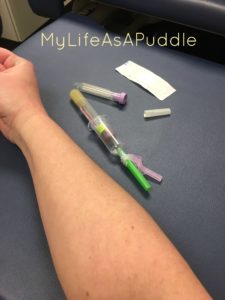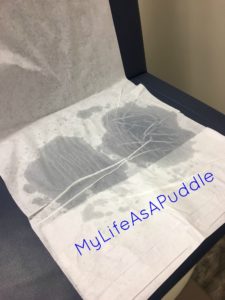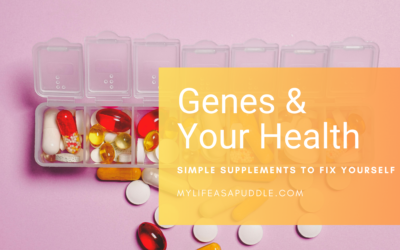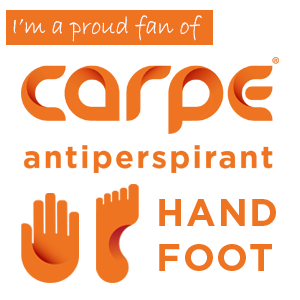Hello sweaty friends! Check out the facelift I gave my blog. It’s much more modern looking now, don’t you think?
Last week I told you about the new underarm treatment study that’s currently enrolling participants who have axillary hyperhidrosis (excessive sweating in the underarms). I’ve been to the dermatologist in my area twice now for the initial screening, and there are several things I took note of that will help you as you begin your own clinical trial process.
This was the first time in my life I was actually hoping I’d sweat really bad!
1. Stop Wearing Antiperspirant Several Days Before Your First Appointment
You will undergo a sweat test, and this first appointment when they do it is crucial. If you don’t meet the sweat measurement protocol at visit 1, you won’t qualify for visits 2 – 4, which are also pre-screening visits. The day of visit 1, you’ll arrive between 7 and 11 am with clean-shaven underarms (at least for the ladies; men, I’m not sure) and wearing no deodorant or antiperspirant. They’ll place cotton pads under each arm and measure the amount of sweat over a 5-minute period. Once they remove the pads, they are placed in a vial, capped, and then the weight of the vial is measured. I believe the protocol is 150mg total (how they can measure sweat in milligrams is beyond me – I think it should be grams or milliliters, but I’m no scientist) between the two underarms. Note: it’s okay to wear plain deodorant for the several days approaching visit 1. The day of the visit you will wear nothing.
2. Wear Proper Clothing
I arrived in a short-sleeved dress, leggings, and a cardigan. Since my armpits were covered by my dress, I had to wear a paper vest from the waist up. Now, normally doctor’s offices and paper gowns get me really worked up and sweaty, but this time it wasn’t happening. Crazy, right?
Before I changed clothes into the paper gown, I had already been in the exam room for about 30 minutes answering questionnaires and giving some medical history to the staff. There was plenty of time for me to adapt to the temperature of the room and calm down a little bit. Plus, the staff were really nice and made me feel very comfortable, reducing my fight-or-flight response that those with hyperhidrosis normally experience. Because of this, I was not sweating under my arms like I thought I would. I was actually cold sitting there in the flimsy gown.
We attempted the sweat test a second time after I slipped my cardigan on over the gown and sat there for a few minutes. I tried to think of things that would make me get riled up and sweaty, so I pulled out my phone and started texting Lisa at the International Hyperhidrosis Society. She’s the one who told me about the study, so I started angrily typing to her that the sweat protocol was outlandish and would reduce the number of participants these dermatologists would get. My hands were nice and drippy after that, and apparently it got my pits wet enough, too. The round 2 sweat test was successful, and I qualified for visits 2 – 4.
So, ladies, wear a tank top and a long-sleeved button up shirt or a cardigan, that way you don’t have to do the paper gown and can keep some of the heat trapped inside to produce an adequate amount of sweat. Guys, I’d also recommend a tank top undershirt if you have one, layered with a button down shirt so you can keep both on as well. They just need to be able to access your underarms to place the pads.
3. Hydrate Before Visit 1
If you pass the sweat test, you will then have blood drawn; ladies will have a pregnancy test via urine performed if they are of child-bearing age. I didn’t know this, so my veins weren’t exactly plump and ready for the nurse. Make sure you are drinking plenty of fluids the day before and the morning of visit 1 so that your veins are primed for the taking and you have to pee.
4. Seat Yourself Strategically
Visit 1 is probably the longest visit you’ll have. The staff will go over your medical history, you’ll meet the dermatologist, perform the sweat test, have blood drawn, etc. I was there for nearly 2 hours, and most of the time I was sitting on the exam table on that horrific crinkly and noisy paper. So imagine what it’s like sitting there that long on hard vinyl with a thin layer of paper over it. Absolutely no air flow. Combine that with the leggings I was wearing (which don’t normally make me sweat), and you have the perfect recipe for a puddle.
And I can’t believe I’m about to post this picture on the Internet, but here you go. This one’s for my sweaty homies.
So decide where you’re most comfortable sitting, but also think about what will make you sweat the most, because for once you do want to be a wreck in order to qualify for the clinical trial. There was a chair in the exam room, so after I was dressed I moved to the chair to finish the appointment.
Up next, visit 2. Stay tuned for more sweaty adventures. And, if you haven’t called 866-72-SWEAT to enroll in the study, what in the sweaty hell are you waiting for?! Join me, and together we can find an effective treatment for hyperhidrosis.








